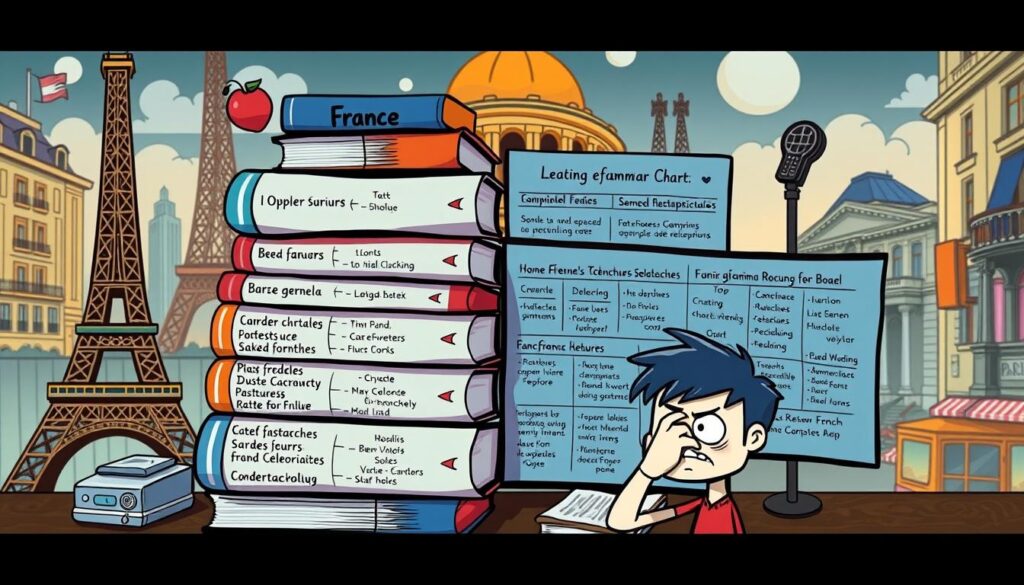Dive into the art of cooking by learning kitchen French vocabulary. This skill adds elegance and a sense of sophistication to your dishes. Understanding these terms provides insight into France’s deep food culture. It makes your meals more enjoyable by adding tradition and creativity. Learn words like mise en place, foie gras, and roux. These terms turn your kitchen into a place where food is both made and deeply appreciated.

Learning French cooking terms is a journey that changes how you cook. It connects chefs and home cooks to a culture that loves and values meal preparation. It’s not just about learning new words; it’s about improving your cooking. Adding French terms to your cooking routine can completely transform your approach to food. By doing this, you’re not just cooking; you’re diving into the rich traditions of food and its history.
The Importance of French Culinary Terms in Modern Cooking
The importance of French culinary terms is huge in today’s cooking world. French gastronomy got recognized by UNESCO in 2010. This shows France’s big impact on cooking. It also shows how critical cooking terminology in French is in kitchens today. French culinary terms are detailed. They help make recipes clear and exact.
Knowing the language of the kitchen in French helps chefs cook better. For instance, blondir means to cook until golden brown. déglacer means to dissolve cooking bits for flavor. This special cooking vocabulary in French is taught at cooking schools. You see it in top restaurants and on cooking shows like “Top Chef”.
Learning terms like ganache, mijoter, and roux leads to trying more French dishes. These words are keys to mastering complex recipes. For example, La Varenne’s book from 1651 is a big deal in French cooking. It has terminologies that are still used today.
Georges Auguste Escoffier’s book in 1903 made French cooking more famous. It built upon La Varenne’s ideas. Escoffier made the kitchen run smoother by creating specific roles. This showed the need for a common cooking terminology in French. It made kitchens around the world work better.
Learning the language of the kitchen in French honors tradition. It pushes chefs towards greatness. It lets chefs everywhere understand French cuisine’s deep influence. Shows like “La Cuisine des Mousquetaires” or working in top restaurants highlight this. The importance of French culinary terms is clear. They are crucial in cooking today.
Understanding French Culinary Language
The French culinary language shows a careful and respectful way of cooking. Knowing French culinary words can really change how you cook. It affects everything from how you prepare to how you present food.
Mise en Place: Getting Everything Ready
A key term in French cooking is “mise en place,” meaning “putting in place.” It’s about preparing all your ingredients before you begin. This practice makes sure you’re ready to cook without searching for things.
- Ensure precision and order in your cooking process
- Avoids delays and keeps you organized
- Crucial for executing complicated recipes perfectly
Basic French Kitchen Terms You Need to Know
To really get French cuisine, you need to know basic French kitchen terms. Here’s a guide to some commonly used terms:
| Term | Definition |
|---|---|
| Roux | A mixture of fat (especially butter) and flour used in making sauces |
| Bouquet Garni | A bundle of herbs usually used to prepare soup, stock, and stews |
| Confit | A method of cooking meat slowly in fat |
| Bain-Marie | A water bath used to gently heat or cook food items |
| Chiffonade | Finely shredded leafy vegetables or herbs |
French kitchen terms are more than cooking techniques; they’re part of French culinary art. Using these phrases will boost your cooking skills. And it will deepen your love for cooking.
Kitchen French Vocabulary: Learn Essential Terms
Getting to know kitchen French words is like finding a key to culinary treasures. Terms like blanchir (blanch), braiser (braise), and mise en place (everything in its place) are central. They help chefs and cooking enthusiasts make meals with great skill. Knowing these terms helps you follow French cooking traditions. This makes your food authentic and refined.
In French homes, kitchens are well-stocked, showing the importance of kitchen vocabulary. When cooking, items such as measuring cups are always used. Vegetable peelers and potato mashers are also common, used 80% and 60% of the time. Knowing these terms is crucial. It’s also true for dinnerware like plates, glasses, forks, and napkins that are often mentioned.
Understanding kitchen French words can make you a better cook. It’s vital for both simple and fancy French meals. Knowing these terms is a must.
Take a look at some common kitchen terms in French and their gender:
- La cuillère (F) – Spoon
- Le couteau (M) – Knife
- Le verre (M) – Glass
- La fourchette (F) – Fork
In French cooking classes, students learn through doing. They set tables (mettre la table), wash veggies (laver les légumes), and cook meals. This practical approach helps.
Learning kitchen French lets you dig deeper into French cooking. It allows you to make dishes that are rich in flavor and cultural significance.
Common Cooking Techniques and Their Descriptions
Learning French cooking starts by knowing the main common cooking techniques. These methods bring out the rich flavors and textures. Knowing these cooking terms and methods is a must for culinary fans wanting to up their game.
Sauté and Simmer: Mastering the Basics
To sauté means cooking quickly over high heat with little fat. It gives a caramelized, tasty surface. It’s great for cooking vegetables, meats, and seafood. Simmering, however, means cooking slowly in liquid just below boiling. It lets the flavors blend well. These techniques are basics in culinary French vocabulary. They’re key for making tasty dishes like “ratatouille” or “boeuf bourguignon.”
Braise and Poach: Elevate Your Cooking
Braising mixes browning food in fat with the softness of slow cooking in liquid. Known as “braiser” in French, it’s great for dishes like “coq au vin” or “boeuf à la mode.” On the other hand, poaching cooks food in barely simmering liquid. It’s called “pocher” in French. It’s best for delicate items like fish, eggs, and fruits to keep them tender.
French cuisine is rich with history, using these common cooking techniques since the 14th century. Techniques like sautéing, simmering, braising, or poaching show careful attention to detail. This transforms simple ingredients into amazing foods.
Key Ingredients and Their French Names
Learning key ingredient names in French is critical if you’re into French cooking. Getting to know phrases such as “foie gras” is necessary. “Foie gras” means luxurious duck or goose liver, a favorite in French meals. Also, you’ll need to know words like “bouillon” (broth) and “pâte feuilletée” (puff pastry) to cook French dishes right.
Improving your French cuisine vocab also means learning kitchen terms in French. For example, “blanc d’oeuf” means egg whites, and “bouquet garni” is a bundle of herbs. Another term is “roux.” It is a mix of flour and fat used to thicken sauces. These elements have deep roots and are key for French cuisine’s unique tastes.
| Ingredient | French Name | Category |
|---|---|---|
| Meat | Viande | Protein |
| Chicken | Poulet | Protein |
| Beef | Bœuf | Protein |
| Carrot | Carotte | Vegetable |
| Eggplant | Aubergine | Vegetable |
| Scallops | Coquille St Jacques | Seafood |
| Parsley | Persil | Herb |
| Basil | Basilic | Herb |
| Butter | Beurre | Dairy |
| Cheese | Fromage | Dairy |
Moreover, the French culinary language includes terms for special items and techniques. Take pork products, for instance. “Andouillette” (pork sausage) and “jambon” (ham) are two examples. Knowing these essential kitchen words in French can boost your cooking skills and deepen your love for French food.
So, as you go deeper into French cooking or want to spice up your kitchen talks, using these French names is smart. It helps make your dishes feel more genuine. It’s a great way to add authenticity to what you cook.
Advanced French Cooking Terms for the Aspiring Chef
Exploring advanced French cooking terms is thrilling. It can take your cooking skills to new heights. The term “en croute” describes food wrapped in pastry and baked. Another key term is “blanquette,” a white stew with veal, carrots, onions, celery, and mushrooms. Knowing these terms lets you make complex dishes with confidence.
Learning these terms is key to understanding high-level cooking. “Mirepoix” is a mix of onions, celery, and carrots used in soups and stews. “Fondue” can mean a cheese dish or a method to make ingredients pulpy, improving taste and texture. These terms unlock the secrets of French culinary techniques.
Terms like “au gratin” highlight the importance of presentation. They involve topping dishes with cheese and breadcrumbs, then baking them. “Pâte a choux” is vital for making pastries like éclairs. Getting familiar with these terms prepares you for complex recipes. It shows deep respect for French culture and aids your chef journey.


